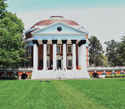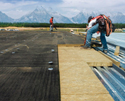In March, RCI Inc. held its 29th International Convention and Trade Show. The event included 21 educational sessions offered in a symposium-style format with formal presentations and papers published in proceedings. Following is a brief overview of several of the roofing-related topics.
Measuring thermal benefits
In "Conventional Roofing Assemblies: Measuring the Thermal Benefits of Light to Dark Roof Membranes and Alternative Insulation Strategies," Graham Finch, building science engineer with RDH Building Engineering Ltd., Vancouver, British Columbia, presented the results of a field and laboratory research project of a test roof consisting of three (white, gray and black) two-ply SBS polymer-modified bitumen membranes installed over three insulation types (polyisocyanurate, mineral wool, and a hybrid of a polyisocyanurate base layer and a mineral wool cover board). The three insulation types were installed to have a similar overall R-value.
The research findings show the roof systems with a mineral wool insulation and hybrid insulation combination maintain R-values close to their published R-values, whereas the polyisocyanurate insulation roof system's R-value notably dropped when exposed to cold or hot outdoor temperatures and solar radiation-induced temperatures.
Wind uplift
In "Influence of Steel Decks on the Wind Uplift Resistance of Commercial Roofs—Facts and Myths," Bas Baskaran, group leader for Building Envelope and Materials for National Research Council Canada, Ottawa, Ontario, presented analysis and testing of several steel roof deck types and their influence on fastener pullout resistance. Four common deck types were measured and tested: 22 gauge 33 kilopound per square inch (ksi), 22 gauge 80 ksi, 20 gauge 33 ksi and 20 gauge 80 ksi.
Actual deck thicknesses for three of the deck types measured equal to or greater than their nominal thicknesses; however, one measured 6 percent less than its nominal thickness. Also, the 33-ksi yield strength deck specimens were found to have actual yield strengths 51 percent greater than their nominal values; the 80-ksi specimens were found to be 29 percent greater than nominal.
The paper concludes designers' use of nominal design values may not be representative of installed steel roof decks. It would be useful if testing agencies such as FM Approvals reported fastener pullout values.
In "Roofing Wind Speeds: ASCE 7, Uplift Ratings, and Warranties," Brian Chamberlain, senior project analyst for Carlisle Construction Materials, Carlisle, Pa., provides a detailed overview of the process for properly designing low-slope membrane roof systems for design wind speeds.
The paper recommends "… if the building being specified is not FM Global-insured, … FM Global should not be listed or referenced in the specification … ."
The paper also recommends specification of a wind warranty only should be considered after the roof assembly has been properly designed for wind uplift and the roof system selected; the presence of a wind warranty should not dictate roof system selection.
In "Design of Nonballasted Low-slope Roof Assemblies for Wind Resistance—the Current Situation and Recommendations for the Future," Madan Mehta, professor of architecture at the University of Texas at Arlington, and Stephen Patterson, director of engineering services for Roof Technical Services Inc., Fort Worth, Texas, analyzed three common design wind load determination methods.
ASCE 7-10, "Minimum Design Loads for Buildings and Other Structures," which is incorporated into most buildings codes, does not include a safety factor. When using ASCE 7, many designers incorporate a safety factor of 2 derived from ASTM D6630, "Standard Guide for Low-slope Insulated Roof Membrane Assembly Performance."
ANSI/SPRI WD-1-12, "Wind Design Standard Practice for Roofing Assemblies," is reported to be based on ASCE 7-10; however, it results in an effective safety factor of 2.35.
FM Global's Loss Prevention Data Sheet 1-28, "Design Wind Loads," is reported to be based on ASCE 7-05. However, compared with ASCE 7-10, it results in an effective safety factor ranging from 2.2 to 3.5 depending on a building's location and risk category.
The authors conclude ANSI/SPRI WD-1 or FM 1-28 result in a notable overdesign when compared with ASCE 7-10 and call for an industry consensus on safety factor value.
Proceedings
Other topics were presented during the convention; the proceedings from RCI's convention are available by accessing RCI's website, www.rci-online.org.
Mark S. Graham is NRCA's associate executive director of technical services.



